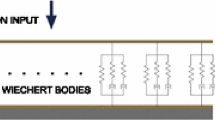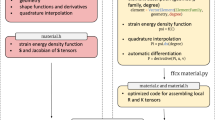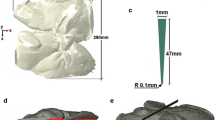Abstract
Background
Development of a laparoscopic surgery simulator that delivers high-fidelity visual and haptic (force) feedback, based on the physical models of soft tissues, requires the use of empirical data on the mechanical behavior of intra-abdominal organs under the action of external forces. As experiments on live human patients present significant risks, the use of cadavers presents an alternative. We present techniques of measuring and modeling the mechanical response of human cadaveric tissue for the purpose of developing a realistic model. The major contribution of this paper is the development of physics-based models of soft tissues that range from linear elastic models to nonlinear viscoelastic models which are efficient for application within the framework of a real-time surgery simulator.
Methods
To investigate the in situ mechanical, static, and dynamic properties of intra-abdominal organs, we have developed a high-precision instrument by retrofitting a robotic device from Sensable Technologies (position resolution of 0.03 mm) with a six-axis Nano 17 force-torque sensor from ATI Industrial Automation (force resolution of 1/1,280 N along each axis), and used it to apply precise displacement stimuli and record the force response of liver and stomach of ten fresh human cadavers.
Results
The mean elastic modulus of liver and stomach is estimated as 5.9359 kPa and 1.9119 kPa, respectively over the range of indentation depths tested. We have also obtained the parameters of a quasilinear viscoelastic (QLV) model to represent the nonlinear viscoelastic behavior of the cadaver stomach and liver over a range of indentation depths and speeds. The models are found to have an excellent goodness of fit (with R 2 > 0.99).
Conclusions
The data and models presented in this paper together with additional ones based on the principles presented in this paper would result in realistic physics-based surgical simulators.









Similar content being viewed by others
References
Mack MJ (2001) Minimally invasive and robotic surgery. JAMA 385(5):568–572
Basdogan C, Ho C, Srinivasan MA (2001) Virtual environments for medical training: graphical and haptic simulation of laparoscopic common bile duct exploration. IEEE/ASME Trans Mechatronics 6(3):269–285
Satava RM, Jones SB (1997) Virtual environments for medical training and education. Presence 6(2):139–146
Tendick F, Downes M, Goktekin T, Cavusoglu MC, Feygin D, Wu X, Eyal R, Hegarty M, Way LW (2000) A virtual environment testbed for training laparoscopc surgical skill. Presence 9(3):236–255
Srinivasan MA, Basdogan C (1997) Haptics in virtual environments: taxonomy, research status, and challenges. Comput Graph 21(4):393–404
Seymour NE, Gallagher AG, Roman SA, OrsquoBrien MK, Bansal VK, Andersen DK, Satava RM (2002) Virtual reality training improves operating room performance: results of a randomized double-blinded study. Ann Surg 236:458–464
Bholat OS, Haluck RS, Murray WB, Gorman PJ, Krummel TM (1999) Tactile feedback is present during minimally invasive surgery. J Am Coll Surg 189:349–355
Picod G, Jambon AC, Vinatier D, Dubois P (2005) What can the operator actually feel when performing a laparoscopy? Surg Endosc 19(1):95–100
Lamata P, Gómez E, Sánchez-Margallo F, Lamata F, Pozo F, Usón J (2006) Tissue consistency perception in laparoscopy to define the level of fidelity in virtual reality simulation. Surg Endosc 20(9):1368–1375
Cao CGL, Zhou M, Jones DB, Schwaitzberg SD (2007) Can surgeons think and operate with haptics at the same time? J Gastrointest Surg 11:1564–1569
Fung YC (1993) Biomechanics: mechanical properties of living tissues, 2nd edn. Springer Verlag, Berlin, Germany
Yamada H (1970) Strength of biological materials. Williams & Wilkins, Baltimore
Schwartz J-M, Denninger M, Rancourt D, Moisan C, Laurendeau D (2005) Modeling liver tissue properties using a non-linear visco-elastic model for surgery simulation. Med Image Anal 9(2):103–112
Roan E, Vemaganti K (2007) The nonlinear material properties of liver tissue determined from no-slip uniaxial compression experiments. J Biomech Eng 129(3):450–456
Kim SM, McCulloch TM, Rim K (1999) Comparison of viscoelastic properties of the pharyngeal tissue: human and canine. Dysphagia 14:8–16
Gerad JM, Ohayon J, Luboz V, Perrier P, Payan Y (2005) Non-linear elastic properties of the lingual and facial tissues assessed by indentation technique Application to the biomechanics of speech production. Med Eng Phys 27:884–892
Samur E, Sedef M, Basdogan C, Avtan L, Duzgun O (2007) A robotic indenter for minimally invasive measurement and characterization of soft tissue behavior. Med Image Anal 11(4):361–373
Mazza E, Nava A, Bauer M, Winter R, Bajka M, Holzapfel A (2006) Mechanical properties of the human uterine cervix: an in vivo study. Med Image Anal 10(2):125–136
Tay BK, Kim J, Srinivasan MA (2006) In vivo mechanical behavior of intra-abdominal organs. IEEE Trans Biomed Eng 53(11):2129–2138
Kim J, Srinivasan MA (2005) Characterization of viscoelastic soft tissue properties from in vivo animal experiments and inverse FE parameter estimation. MICCAI 3750:599–606
Ottensmeyer MP (2002) In vivo measurement of solid organ viscoelastic properties. Medicine Meets Virtual Reality. Studies Health Technol Inform 85:328–333
Tay B, De S, Srinivasan MA (2002) In vivo force response of intra-abdominal soft tissues for the simulation of laparoscopic procedures, Medicine Meets Virtual Reality: 10, Newport Beach, January
Ehman RL, Muthupillai R, Lomas DJ, Rossman PJ, Greenleaf JF, Manduca A, Riederer SJ (1995) Magnetoelastography MRI of acoustic strain waves. Radiology 179:335
Gao L, Parker KJ, Lerner RM, Levinson SF (1996) Imaging of the elastic properties of tissue – a review. Ultrasound Med Biol 22(8):959–977
Loomis JM, Lederman SJ (1986) Tactual perception. In: Boff K, Kaufman L, Thomas J (eds) Handbook of perception and human performance. Wiley, New York, pp 31–41
Miller K, Chinzei K, Orssengo G, Bednarz P (2000) Mechanical properties of brain tissue in-vivo: experiment and computer simulation. J Biomech 33:1369–1376
Zheng YP, Mak A (1996) An ultrasound indentation system for bio-mechanical properties assessment of soft tissues in vivo. IEEE Trans Biomed Eng 43(9):912–918
Zheng YP, Mak A (1999) Effective elastic properties for lower limb soft tissues from manual indentation experiment. IEEE Trans Rehabil Eng 7:257–267
Scilingo EP, DeRossi D, Bicchi A, Iacconi P (1997) Haptic display for replication of rheological behavior of surgical tissues: modelling, control, and experiments. Proc ASME Dyn Syst Control Div 173–176
Brown JD, Rosen J, Moreyra M, Sinanan M, Hannaford B (2002) Computer-controlled motorized endoscopic grasper for in vivo measurements of soft tissue biomechanical characteristics. Medicine Meets Virtual Reality 85:71–73
Aoki T, Ohashi T, Matsumoto T, Sato M (1997) The pipette aspiration applied to the local stiffness measurement of soft tissues. Ann Biomed Eng 25:581–587
Kauer M, Vuskovic V et al (2002) Inverse finite element characterization of soft tissues. Med Image Anal 6(3):275–287
Hannaford B, Trujillo J, Sinanan M, Moreya M, Rosen J, Brown J, Leuschke R, MacFarlane M (1998) Computerized Endoscopic Surgical Grasper. Proceedings of MMVR Conference 1998 265–271
Torres-Moreno R (1991) Biomechanical analysis of the interaction between the above-knee residual limb and the prosthetic socket. PhD dissertation. University of Strathclyde, Glasgow, UK
Huwart L, Peeters F, Sinkus R, Annet L, Salameh N, ter Beek LC, Horsmans Y (2006) Liver fibrosis: non-invasive assessment with MR elastography. NMR Biomed 19(2):173–179
De S, Lim Y-J, Muniyandi M, Srinivasan MA (2006) Physically realistic virtual surgery using the point-associated finite field (PAFF) approach. Presence 15(3):294–308
Lim Y-J, De S (2007) Real time simulation of nonlinear tissue response in virtual surgery using the point collocation-based method of finite spheres. Comput Methods Appl Mech Eng 196(31–32):3011–3024
Banihani S, De S. A comparison of some model order reduction methods for fast simulation of soft tissue response using the point collocation-based method of finite spheres (PCMFS) Engineering with Computers (in press)
Hayes WC, Keer LM, Herrmann G, Mockros LF (1972) A mathematical analysis for indentation tests of articular cartilage. J Biomech 5:541–51
Johnson GA, Liversay GA, Woo SL, Rajagopal KR (1996) A single integral finite strain viscoelastic model of ligaments and tendons. J Biomech Eng 118:221–226
Carew EO, Talman EA, Boughner DR, Vesely I (1999) Quasi-linear viscoelastic theory applied to internal shearing of porcine aortic valve leaflets. J Biomech Eng 121:386–392
Shames IH, Cozzarelli FA (1997) Elastic and inelastic stress analysis. Taylor and Francis, Bristol, PA, USA
Press WH, Flannery BP, Teukolsky SA, Vetterling WT (1992) Numerical recipes in C: the art of scientific computing, 2nd edn. Cambridge University Press, Cambridge
Rivlin RS (1948) Large elastic deformations of isotropic materials—further developments of the general theory. Philos Trans R Soc Lond A Math Phys Sci 241:379
Ogden RW (1972) Large deformation isotropic elasticity – correlation of theory and experiment for incompressible rubberlike solids. Philos Trans R Soc Lond A Math Phys Sci 326:565
Yeoh OH (1993) Some forms of the strain-energy function for rubber. Rubber Chem Technol 66:754
Viidik A, Vuust J (1978) Biology of collagen: proceedings of a symposium. Academic, Aarhus, London
Egorov IE, Schastlivtsev IV, Prut EV, Baranov AO, Turusov RO (2002) Mechanical properties of the human gastrointestinal tract. J Biomech 35:1417–1425
Acknowledgements
Support for this research was provided by grant R21 EB003547-01 from the NIH. Special thanks are due to Mr. C. Kennedy and Dr. J. Vlazny of US Surgical, Dr. A. Patel of Beth Israel Deaconess Medical Center, and Dr. L. Martino and Dr. D. Conti of Albany Medical Center. Thanks are also due to the Anatomical Gifts Program of the Albany Medical College.
Author information
Authors and Affiliations
Corresponding author
Rights and permissions
About this article
Cite this article
Lim, YJ., Deo, D., Singh, T.P. et al. In situ measurement and modeling of biomechanical response of human cadaveric soft tissues for physics-based surgical simulation. Surg Endosc 23, 1298–1307 (2009). https://doi.org/10.1007/s00464-008-0154-z
Received:
Revised:
Accepted:
Published:
Issue Date:
DOI: https://doi.org/10.1007/s00464-008-0154-z




